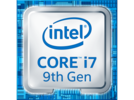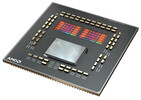Intel Core i7-9700 vs AMD Ryzen 9 5950X vs Intel Core i9-9900K
Intel Core i7-9700
► remove from comparison
The Intel Core i7-9700 is a high end desktop processor based on the Coffee Lake architecture. It integrates 8 cores (no Hyperthreading therefore also 8 threads) clocked at 3 - 4.7 GHz. Compared to the similar named Core i7-9700K, the 9700 has no open multiplicator for easy overclocking, offers lower clock speeds and offers a reduced TDP.
Compared to the old Core i7-8700, the 9700 offers two more real cores but no Hyperthreading. Therefore, the performance gain is not that big - depending on the app. The single core performance was slightly improved thanks to the higher Turbo clocks. As a high end desktop CPU, the i7-9700 is well suited for demanding tasks and gaming.
The integrated Intel UHD Graphics 630 graphics card is clocked at up to 1.2 GHz and offers no advantage compared to previous generations. As it is a very low end GPU, only some low demanding games like Hearthstone can be played with it (see GPU page for benchmarks).
Intel specifies the TDP at 65 Watt (instead of the 95W of the faster models) and therefore the CPU wont need a high end desktop cooling system.
AMD Ryzen 9 5950X
► remove from comparison
The AMD Ryzen 9 5950X is a high-end 16-core, hyperthreaded (SMT) Vermeer Series desktop processor. With 32 threads, the new flagship offers as many threads as the AMD Ryzen 9 3950X. Introduced on October 8, 2020, the Ryzen 9 5950X is the fastest 16-core processor and is specified at 105 watts TDP.
The Ryzen 9 5950X runs at 3.4 GHz to 4.9 GHz (single core). Wen all 16 cores are loaded, up to 4.5 GHz are still possible.
The internal structure of the processor has not changed fundamentally at first glance. The CCX structure has changed a bit compared to Zen 2, because now a CCX consists of up to 8 CPU cores. So each individual core can access the complete L3 cache (32 MByte). Furthermore the CCX modules are connected to each other via the same I/O die, which we already know from Zen2. According to AMD, the Infinity fabric should now reach clock rates of up to 2 Ghz, which in turn allows a RAM clock of 4,000 MHz without performance loss.
Performance
The average 5950X in our database matches the Core i9-12900K, the Core i9-12900HX and also the Ryzen Threadripper 2970WX in multi-thread performance, making this Ryzen a great processor for pretty much any task imaginable as of mid 2022.
Power consumption
This Ryzen 9 series chip has a default TDP (also known as the long-term power limit) of 105 W. It will, however, happily consume much more than that as long as the cooling solution is able to handle the heat - even before one starts considering the possibility of overclocking the thing.
The Ryzen 9 5950X is built with TSMC's 7 nm process for average, as of mid 2023, energy efficiency.
Intel Core i9-9900K
► remove from comparisonThe Intel Core i9-9900K is a high end desktop processor based on the Coffee Lake architecture. At the time of announcement in late 2018, the 9900K is the fastest Coffee Lake CPU and offers an open multiplicator for easy overclocking. The CPU integrates 8 cores (16 threads) clocked at 3.6 - 5 GHz and it needs a new Z390 based mainboard.
Thanks to the two additional cores, the performance in multi-threaded applications is up to 25 % faster than the older Core i7-8700K. The single thread performance is only slightly faster due to the higher clock speeds. As a high end desktop CPU, the i9-9900K is suited even for very demanding applications and perfect for 3D gaming.
The integrated Intel UHD Graphics 630 graphics card is clocked at up to 1.2 GHz and offers no advantage compared to previous generations. As it is a very low end GPU, only some low demanding games like Hearthstone can be played with it (see GPU page for benchmarks).
Intel specifies the TDP at 95 Watt, so if the CPU is used in laptops a big and chunky cooling system is needed to avoid throttling and lower clock speeds under sustained loads. When overclocking the CPU, the power consumption can easily rise up to 200 Watt and higher.
| Model | Intel Core i7-9700 | AMD Ryzen 9 5950X | Intel Core i9-9900K | ||||||||||||||||||||||||||||||||||||||||||||||||||||||||||||||||||||||||||||||||
| Codename | Coffee Lake-R | Vermeer (Zen 3) | Coffee Lake-R | ||||||||||||||||||||||||||||||||||||||||||||||||||||||||||||||||||||||||||||||||
| Series | Intel Coffee Lake | AMD Vermeer (Ryzen 5000) | Intel Coffee Lake | ||||||||||||||||||||||||||||||||||||||||||||||||||||||||||||||||||||||||||||||||
| Series: Coffee Lake Coffee Lake-R |
|
|
| ||||||||||||||||||||||||||||||||||||||||||||||||||||||||||||||||||||||||||||||||
| Clock | 3000 - 4700 MHz | 3400 - 4900 MHz | 3600 - 5000 MHz | ||||||||||||||||||||||||||||||||||||||||||||||||||||||||||||||||||||||||||||||||
| L1 Cache | 512 KB | 1 MB | 512 KB | ||||||||||||||||||||||||||||||||||||||||||||||||||||||||||||||||||||||||||||||||
| L2 Cache | 2 MB | 8 MB | 2 MB | ||||||||||||||||||||||||||||||||||||||||||||||||||||||||||||||||||||||||||||||||
| L3 Cache | 12 MB | 64 MB | 16 MB | ||||||||||||||||||||||||||||||||||||||||||||||||||||||||||||||||||||||||||||||||
| Cores / Threads | 8 / 8 | 16 / 32 | 8 / 16 | ||||||||||||||||||||||||||||||||||||||||||||||||||||||||||||||||||||||||||||||||
| TDP | 65 Watt | 105 Watt | 95 Watt | ||||||||||||||||||||||||||||||||||||||||||||||||||||||||||||||||||||||||||||||||
| Technology | 14++ nm | 7 nm | 14++ nm | ||||||||||||||||||||||||||||||||||||||||||||||||||||||||||||||||||||||||||||||||
| Die Size | 178 mm2 | CPU cores: 2x 80.7 sq. mm., I/O: 125 mm2 | 178 mm2 | ||||||||||||||||||||||||||||||||||||||||||||||||||||||||||||||||||||||||||||||||
| max. Temp. | 100 °C | 100 °C | |||||||||||||||||||||||||||||||||||||||||||||||||||||||||||||||||||||||||||||||||
| Socket | FCLGA1151 | AM4 | FCLGA1151 | ||||||||||||||||||||||||||||||||||||||||||||||||||||||||||||||||||||||||||||||||
| Features | Dual-Channel DDR4-2666 Memory Controller, HyperThreading, AVX, AVX2, AES-NI, TSX-NI, Quick Sync, Virtualization, vPro | DDR4-3200 RAM, PCIe 4, MMX (+), SSE, SSE2, SSE3, SSSE3, SSE4.1, SSE4.2, SSE4A, AES, AVX, AVX2, FMA3, SHA | Dual-Channel DDR4-2666 Memory Controller, HyperThreading, AVX, AVX2, AES-NI, TSX-NI, Quick Sync, Virtualization, vPro | ||||||||||||||||||||||||||||||||||||||||||||||||||||||||||||||||||||||||||||||||
| iGPU | Intel UHD Graphics 630 (350 - 1200 MHz) | Intel UHD Graphics 630 (350 - 1200 MHz) | |||||||||||||||||||||||||||||||||||||||||||||||||||||||||||||||||||||||||||||||||
| Architecture | x86 | x86 | x86 | ||||||||||||||||||||||||||||||||||||||||||||||||||||||||||||||||||||||||||||||||
| Announced | |||||||||||||||||||||||||||||||||||||||||||||||||||||||||||||||||||||||||||||||||||
| $799 U.S. | $488 U.S. | ||||||||||||||||||||||||||||||||||||||||||||||||||||||||||||||||||||||||||||||||||
| Manufacturer | www.amd.com | www.intel.de |
Benchmarks
Average Benchmarks Intel Core i7-9700 → 100% n=37
Average Benchmarks AMD Ryzen 9 5950X → 198% n=37
Average Benchmarks Intel Core i9-9900K → 125% n=37
* Smaller numbers mean a higher performance
1 This benchmark is not used for the average calculation












